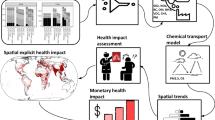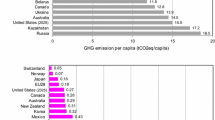Abstract
Using the GAINS (Greenhouse Gas–Air Pollution Interactions and Synergies) model, we derived Annex I marginal abatement cost curves for the years 2020 and 2030 for three World Energy Outlook baseline scenarios (2007–2009) of the International Energy Agency. These cost curves are presented by country, by greenhouse gas and by sector. They are available for further inter-country comparisons in the GAINS Mitigation Efforts Calculator—a free online tool. We illustrate the influence of the baseline scenario on the shape of mitigation cost curves, and identify key low cost options as well as no-regret priority investment areas for the years 2010–2030. Finally, we show the co-effect of GHG mitigation on the emissions of local air pollutants and argue that these co-benefits offer strong local incentives for mitigation.














Similar content being viewed by others
Notes
The version of the GAINS model we are using covers 36 Annex I countries, which accounted for 96 % of 1990 emissions of the whole of Annex I. In the following we use the label Annex I* for these countries and treat the 27 EU member states as a single party (EU27), though the results are based on country-level modelling.
The fluorinated gases are represented in GAINS by a single gas ‘FGAS’, which is characterized by a global warming potential that is a weighted average of the relevant species in a particular sector and country. Mitigation options reflect the speciation implicitly.
GAINS distinguishes up to 10 distinct climate zones per country.
It is known that individuals and commercial enterprises use higher rates than that of a social planner.
This is true only for technologies with life-times beyond the year 2020.
Contrast this with the 0 and 3 % reduction relative to 1990 by 2020 in the WEO 2007 and WEO 2008 baseline for EU27, respectively.
Hydropower, wind, solar, geothermal. Note that we follow the convention to assign Nuclear power a conversion efficiency of 33%, but 100 % for most renewables, the latter fact explaining partially the increase in primary consumption in 2030 relative to 2005 in the WEO 2009 baseline scenario.
We emphasise again that here we are estimating the economic potential at a given marginal cost. There may be barriers (see below) that prevent agents from choosing options that are economically efficient from a social perspective. In practice, this means that emission reductions to be expected from imposing a carbon price in the form of a tax cannot be read off from the curves in Fig. 5—unless all barriers can be overcome.
For the sake of computational speed we keep the number of points on the curve below 50 and generate curves with 5 €/tCO2eq. steps between 0 and 50 €/tCO2eq. and larger steps above.
We have already indicated above that our cost concept excludes transaction costs, but adequately reflects the social planner’s perspective. In contrast, Stern (2009, p. 50) assumes an average implementation cost of 25 €/tCO2eq. On the basis of this assumption his total cost estimate of 0.8 % of GDP for a 20 GtCO2eq reduction by 2030 amounts to the same as the sum over the implementation costs. Thus, Stern’s calculation suggests that mitigation technology pays for itself, while the real challenge is to reduce transaction costs and to manage institutional change.
The backwards bend of the curve for the Japanese power sector above 100 €/tCO2eq emerges as an accounting effect, when industrial boilers are replaced by combined-heat and power plants. This reduces emissions in industry but increases emissions in the power sector.
Latest figures indicate that this is already taking place now and should be considered to be part of the baseline.
Accessible at http://gains.iiasa.ac.at/MEC/. Registration is required but is free, as is access to all GAINS input data.
An assigned amount unit (AAU) is a tradable 'Kyoto unit' or 'carbon credit' representing an allowance to emit greenhouse gases comprising 1 tonne of CO2eq calculated using their global warming potential.
References
AGO (1999a) Australian commercial building sector. Greenhouse gas emissions 1990–2010. Executive Summary Report 1999. Australian Greenhouse Office, Canberra
AGO (1999b) Australian residential building sector. Greenhouse gas emissions 1990–2010. Executive Summary Report 1999. Australian Greenhouse Office, Canberra
Amann M, Bertok I, Borken J, Cofala J, Heyes C, Höglund L, Klimont Z, Purohit P, Rafaj P, Schoepp W, Toth G, Wagner F, Winiwarter W (2008a) GAINS—potentials and costs for greenhouse gas mitigation in Annex I countries. International Institute for Applied Systems Analysis (IIASA), Laxenburg
Amann M, Kejun J, Hao J et al (2008b) GAINS-Asia: scenarios for cost-effective control of air pollution and greenhouse gases in China. International Institute for Applied Systems Analysis (IIASA), Laxenburg
Amann M, Rafaj P, Höhne N (2009) GHG mitigation potentials in Annex I countries comparison of model estimates for 2020. International Institute for Applied Systems Analysis, Laxenburg
Amann M, Bertok I, Borken-Kleefeld J, Cofala J, Heyes C, Höglund-Isaksson L, Klimont Z, Rafaj P, Schöpp W, Wagner F (2011) Cost-effective emission reductions to improve air quality in Europe in 2020. Scenarios for the negotiations on the revision of the Gothenburg protocol under the convention on long-range transboundary air pollution. Background paper for the 48th Session of the Working Group on Strategies and Review. CIAM Report 1/2011. International Institute for Applied Systems Analysis, Laxenburg
Australian Treasury (2008) Australia’s low pollution future—the economics of climate change mitigation. Commonwealth of Australia
Barker T, Bashmakov I, Alharti A, et al (2007) Mitigation from a cross-sectoral perspective. Climate change 2007. Mitigation. Contribution of Working Group III to the Fourth Assessment Report of the Intergovernmental Panel on Climate Change
Borken-Kleefeld J, Cofala J, Rafaj P (2009) GAINS GHG mitigation potentials and costs in the transport sector—methodology (version 2). International Institute for Applied Systems Analysis, Laxenburg
Bowman AF, Kram T, Klein Goldewijk K (2006) Integrated modelling of global environmental change—an overview of IMAGE 2.4. Netherlands Environmental Assessment Agency (MNP), Bilthoven
Bruinsma J (2003) World agriculture towards 2015/2030. An FAO perspective. World Food and Agricultural Organization/Earthscan, Rome/London
Capros P, Mantzos L, Papandreou V, Tasios N (2008) European energy and transport trends to 2030—update 2007. European Commission Directorate-General for Energy and Transport, Brussels
Cofala J, Purohit P, Rafaj P, Klimont Z (2009) GAINS GHG mitigation potentials and costs from energy use and industrial sources in Annex I countries—methodology. International Institute for Applied Systems Analysis, Laxenburg
den Elzen M, Hare W, Höhne N, Levin K, Lowe J, Riahi K, Rogelj J, Sawin E, Taylor C, van Vuuren D, Ward M (2010) The emissions gap report: are the Copenhagen Accord pledges sufficient to limit global warming to 2 deg. C or 1.5 deg. C? A preliminary assessment. United Nations Environment Programme
Gupta S, Tirpak DA, Burger N, Kruger JA, Michaelowa A, Murase S, Pershing J, Saijo T, Sari A (2007) Policies, instruments and co-operative arrangements. In: Metz B, Davidson OR, Bosch PR, Dave R, Meyer LA (eds) Climate change 2007: mitigation. Contribution of Working Group III to the Fourth Assessment Report of the Intergovernmental Panel on Climate Change, Cambridge University Press, Cambridge, UK
Höglund-Isaksson L, Mechler R (2005) The GAINS model for greenhouse gases, version 1.0: methane (CH4). International Institute for Applied Systems Analysis (IIASA), Laxenburg
Höglund-Isaksson L, Winiwarter W, Tohka A (2009) GAINS potentials and costs for mitigation of non-CO2 greenhouse gases in Annex I countries—methodology (version 2). International Institute for Applied Systems Analysis, Laxenburg
IEA (2005) Projected costs of generating electricity—2005 update. International Energy Agency, Paris
IEA (2007) World Energy Outlook 2007. International Energy Agency, Paris
IEA (2008a) World Energy Outlook 2008. International Energy Agency, Paris
IEA (2008b) Deploying renewables—principles for effective policies. OECD Publishing, International Energy Agency, Paris
IEA (2008c) Energy technology perspectives 2008. International Energy Agency, Paris
IEA (2009) World Energy Outlook 2009. International Energy Agency, Paris
IPCC (2006) 2006 IPCC guidelines for national greenhouse gas inventories. Intergovernmental Panel on Climate Change, IGES, Japan
Kainuma M, Matsuoka Y, Masui T, Takahashi K, Fujino J, Hijioka Y (2007) Climate policy assessment using the Asia-Pacific integrated model. In: Schlesinger M, Kheshgi H, Smith J, Chesnaye F, Reilly J, Wilson R and Kolstad C (eds) Human-induced climate change. Cambridge University Press, Cambridge, UK
Klaassen G, Berglund C, Wagner F (2005) The GAINS model for greenhouse gases—version 1.0: carbon dioxide (CO2). International Institute for Applied Systems Analysis (IIASA), Laxenburg
Kobos PH, Erickson JD, Drennen TE (2006) Technological learning and renewable energy costs: implications for US renewable energy policy. Energy Policy 34:1645–1658
LBNL (2007) The home energy saver—documentation of calculation methodology, input data, and infrastructure. In: Energy Analysis Department, Environmental Energy Technologies Division, Ernest Orlando Lawrence Berkeley National Laboratory, University of California, Berkeley. http://hes.lbl.gov/consumer/
McKinsey (2008) The carbon productivity challenge: curbing global energy demand growth. McKinsey & Company. http://www.mckinsey.com/mgi/reports/pdfs/Carbon_Productivity/MGI_carbon_productivity_full_report.pdf
McKinsey (2009) Pathways to a low-carbon economy—version 2 of the global greenhouse gas abatement cost curve. http://www.mckinsey.com/en/Client_Service/Sustainability/Latest_thinking/Pathways_to_a_low_carbon_economy.aspx
Meinefeld M (2004) Strategische Erfolgsfaktoren für Contracting-Angebote von Energieversorgungsunternehmen. PhD Thesis, University of Paderborn, Department for Economics
Messner S (1997) Endogenized technological learning in an energy systems model. J Evol Econ 7:291–313
Ostrom E (1990) Governing the commons: the evolution of institutions for collective action. Cambridge University Press, Cambridge
Purohit P, Amann M, Mathur R, Bertok I, Borken J, Cofala J, Heyes C, Klimont Z, Rafaj P, Schöpp W, Wagner F, Winiwarter W (2010) GAINS-Asia. Scenarios for cost-effective control of air pollution and greenhouse gases in India. International Institute for Applied Systems Analysis (IIASA), Laxenburg
RITE (2009) RITE GHG mitigation assessment model. Research Institute of Innovative Technology for the Earth (RITE), Japan
Rubin ES, Chen C, Rao AB (2007) Cost and performance of fossil fuel power plants with CO2 capture and storage. Energy Policy 35:4444–4454
Russ P, Ciscar J-C, Saveyn B, Soria A, Szabo L, Van Ierland T, Van Regemorter D, Virdis R (2009) Economic assessment of post-2012 global climate policies. Joint Research Centre of the European Community, Seville
Stern N (2009) A blueprint for a safer planet. Bodley Head, London
Tohka A (2005) The GAINS model for greenhouse gases—version 1.0: HFC, PFC and SF6. International Institute for Applied Systems Analysis, Laxenburg
US-EPA (2005) Global anthropogenic non-CO2 greenhouse gas emissions: 1990–2020. U.S. Environmental Protection Agency, Office of Atmospheric Programs, Climate Change Division, Washington DC
van Vuuren DP, Hoogwijk M, Barker T, Riahi K, Boeters S, Chateau J, Scrieciu S, van Vliet J, Masui T, Blok K, Blomen E, Kram T (2009) Comparison of top-down and bottom-up estimates of sectoral and regional greenhouse gas emission reduction potentials. Energy Policy 37:5125–5139
Vine E (2005) An international survey of the energy service company (ESCO) industry. Energy Policy 33:691–704
Wagner F, Amann M (2009a) Analysis of the proposals for GHG reductions in 2020 made by UNFCCC Annex I countries by mid-August 2009. International Institute for Applied Systems Analysis, Laxenburg
Wagner F, Amann M (2009b) Analysis of the proposals for GHG reductions in 2020 made by UNFCCC Annex I parties: implications of the economic crisis. International Institute for Applied Systems Analysis, Laxenburg
Winiwarter W (2005) The GAINS model for greenhouse gases—version 1.0: nitrous oxide (N2O). International Institute for Applied Systems Analysis (IIASA), Laxenburg
Worrell E, Price L, Neelis M, Galitsky C, Zhou N (2007) World best practice energy intensity values for selected industrial sectors. Lawrence Berkeley National Laboratory, Berkeley
Author information
Authors and Affiliations
Corresponding author
Additional information
Handled by Tatsuya Hanaoka, National Institute of Environmental Studies, Japan.
Rights and permissions
About this article
Cite this article
Wagner, F., Amann, M., Borken-Kleefeld, J. et al. Sectoral marginal abatement cost curves: implications for mitigation pledges and air pollution co-benefits for Annex I countries. Sustain Sci 7, 169–184 (2012). https://doi.org/10.1007/s11625-012-0167-3
Received:
Accepted:
Published:
Issue Date:
DOI: https://doi.org/10.1007/s11625-012-0167-3




